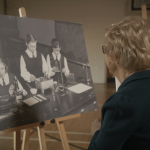MISSION, B.C. (CCN) — It’s hard to imagine Westminster Abbey without Father Dunstan Massey’s artistic fingerprints brushed and carved over and into seemingly every surface.
Throughout the corridors, halls, and church of the Mission abbey, paintings and carvings bear the distinctive style of the Benedictine monk and prolific artist who passed away Dec. 26 at the age of 98.
His best-known works are perhaps the two large frescos and the 23 reliefs that adorn the walls of the abbey church, but lesser-known pieces are hidden in alcoves and stairways.

The art blends into the life of the abbey itself, accompanying the monks throughout their day-to-day lives – demonstrating the love that their creator had for his vocation and the community that often helped him complete his artwork.
On a tour of Father Massey’s artwork, Father Marc Dumont commented on a remarkable number of art pieces that had community collaboration, whether through modelling, carving, metalworking, or weaving the final product.
In return for their help, the artwork enriches the spiritual lives of the brother. “His art does sort of help in prayer. It lifts our hearts and mind – his crucifix especially,” said the Abbey guest master. “Most of his art sort of draws one to think about eternal things.”

He also had a fine attention to detail. Father Dumont remembers seeing the artist monk working on the massive fresco The Heavenly Banquet for more than 10 hours. The plastering process was long and at the end of the day only a dozen or so square inches had been completed. Unsatisfied with his work, Father Massey destroyed the entire section and began again the next day.
The artist’s workspace was still largely intact when our tour arrived at the ordered chaos one might expect from an artist. Paint brushes and paints were all labelled and strewn across the table, seemingly projecting an energy that defies description.
Father Massey was meticulous and detail-oriented, his brother monk said, and left detailed instructions for reproducing the colours in his frescos in case they are damaged in the future.
Such concern was emblematic of the attention to detail that was a cornerstone of his entire life, and up until his final moments he was still checking over drafts of his last unfinished project, a large set of painted Stations of the Cross for the cloister walkway.

Abbot Alban Riley, OSB, recounted the story in his homily for Father Massey’s requiem Mass.
“On the day Father Dunstan died, some of the younger monks who had been helping him with his artwork brought him one of the Stations of the Cross he had been working on until his last sickness,” he said. “He was concerned about possible errors in the draughtsmanship. He checked the panel over briefly as if it were resigned to the Lord.”
Later that afternoon, “Father Dunstan had a very quiet and peaceful death,” he told the congregation. “He seemed to have just fallen asleep.”
“No fanfare or dramatic moments – which you might have expected from Father Dunstan.” Quoting the 17th century allegory The Pilgrim’s Progress, the abbot said, “‘He passed over, and the trumpets sounded for him on the other side.’”
The art of Father Dunstan Massey

The Temptation of St. Benedictwas the first of the major frescos completed in 1974. Itis a striking sight at the end of the cloister hallway. Blue tones and geometric abstraction radiate from the depiction of an episode from the Benedictine founder’s life in which he threw himself in a thorny bush to affirm his commitment to religious life.



In the center, the young St. Benedict is wrapped in thorns, positioned beneath an older image of himself. They are flanked by a pillar from Montecristo monastery on the left and Subiaco monastery on the right, and the rock from which St. Benedict brought forth water on the other. Westminster Abbey is visible to the right of the image.

The Heavenly Banquetresides on the large wall at the end of the dining hall. It was completed in 2005 when Fr. Dustan was 81 years old. Inspired by Leonardo Davinci’s Last Supper the fresco depicts the 11 apostles seated with Christ in Heaven. A joyous scene, it radiates warmth and joy.


Concrete reliefs – there are 23 6’x6’ reliefs in total hung around the church. The Resurrection was the final relief finished in recent years and Saint Michael was the first relief finished in 1980.

The Life of St. Benedict: Various Scenes contains three episodes from the life of St. Benedict that were completed throughout the 1960s. They are mounted above the closet where the brothers keep their choir robes. From left to right: The Miracle of Saint Maurus running on water to save St. Placidus; St. Benedict receives his robes from the monk Romanus; The last meeting of St. Benedict and his sister St. Scholastica.

The Miraculous Catch of Fishwas completed for the abbey’s silver jubilee. The actions scene depicts the apostles pulling in the miraculous catch of fish, while Simon Peter begs Christ to forgive his doubts.



The Tree of Life (The Allegory of the Eucharist) (details) was completed in 1956 and adorns the wall of the old dining hall. The mural depicts monks during the harvest of grapes and wheat that will come together to become the body and blood of Christ which are held buy monks at the center of the painting.

The Stations of the Cross – Father Massey passed away while working on a large set of paintings depicting the stations of the cross. The initial planning has been completed for each image and Father Dumont said they are looking for an artist to finish the project. Each station will hang in place of the personal altars that used to be used by the brothers for daily mass before Vatican II allowed for the con-celebration of the Mass.

The Healing of the Blind Manis hidden away in a stairway, one of the models for the painting was a bald seminarian who Father Dumont says has now been immortalized with hair.

The Mater Dei Tapestrywas designed by Father Massey and woven by the first abbot of the abbey, Abbott Eugene Medved’s, sister in 1953.

This carving of Saint Joseph hangs in the old dining hall. It was designed by Father Massey and carved by one of the brothers.



